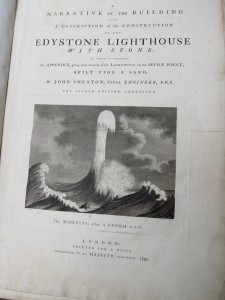
Jonathan Clark Fine Books
Art and Architecture
SMEATON, John
A Narrative Of The Building And A Description Of The Construction Of The Edystone Lighthouse.
London, G[eorge]. Nicol, 1793.
£1650
EnquireFolio (560 x 390 mm.) Bound in contemporary marbled paper-covered boards, recently expertly rebacked and re-cornered in chocolate brown calf, the spine divided into seven compartments with raised bands, black morocco and gilt lettering piece to the second compartment, the remaining compartments blank; pp. xvi, 198, engraved title vignette and 23 full-page, numbered, engraved plates, of which 5 are maps showing the position of Eddystone (1-3) and Spurn Point (19,20), a newspaper cutting dated August, 1848, describing and illustrating the new lantern installed that year as part of extensive renovations undertaken in the late 1840s, pasted to the upper corner of plate 12, illustrating Smeaton's original lantern; the fore-edges age-toned, a small, light waterstain to the lower corner of the last few plates just reaching inside the platemark, otherwise a bright, untrimmed copy.
Provenance: John and Sylvia Reid, architects and furniture designers. Designed, among other pieces, the hugely successful ‘C’ and ‘S’ ranges of furniture for the Stag Cabinet Company.
Second edition. A thorough and handsomely illustrated account by the civil and mechanical engineer, John Smeaton (1724-1792), of the construction of his lighthouse, the third to be built on the treacherous Eddystone Rocks lying nine miles south of Rame Head in Cornwall. The volume commences with a history of the two previous lighthouses, those built by Henry Winstanley and John Rudyerd, respectively. Winstanley’s lighthouse, a wooden structure was started in 1696, survived its first winter in need of repair and was subsequently remodelled, but was destroyed in the Great Storm of 27th November, 1703. John Rudyerd’s replacement, completed in 1709, was somewhat more substantial, having a brick and concrete core, clad with wood, this survived until 1755 when it was destroyed by fire.
Smeaton’s design and methods of construction for his lighthouse were innovative, its profile being modelled on that of the trunk of an oak tree, stability provided by a flared base, the dovetailing of the pre-cut blocks of granite, the use of marble dowels and a hydraulic cement which continued ‘curing’ even when underwater. The light was first lit on 16th October, 1759. It served the maritime community for over one hundred years, before being replaced by the Douglass lighthouse in 1877. The stub of Smeaton’s lighthouse remains on the reef, adjacent to its replacement, the greater part of it being rebuilt on Plymouth Hoe.
In an appendix Smeaton gives an account of the design and construction of a pair of lighthouses at Spurn Point on the Humber estuary.
BAL Early Printed Books 3059: Skempton 1339. ‘With a new setting of type, typographical corrections, ... and the omission of a note on p. vii.’
Stock number: 1028
